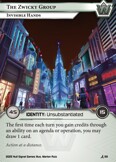Design-wise, Zwicky batches Operations with with Agendas (an ability on an agenda or operation). CF. Nuvem, which batches Operations with Expendables (finish resolving an operation or an action on an expendable card).
And it's a Weyland ID that draws cards!
Its “Earning-Ops-matter” (The first time each turn you gain credits through an ability on an operation or _, …) generalizes WC: Building a Better World’s “Transactions-matter” (Whenever you play a transaction operation, …). For example:
- Each Hedge Fund in BaBW was
Gain 5[$].
- The first Hedge Fund in Zwicky is
Gain 4[$]. Draw 1 card.
Also, it cross-synergizes with Plutus’s “Transactions-matter”. All Transactions can gain credits (and most always do). They're now cantrips (modulo the click) too.
"Draw a card a turn" is the one of the most best lines of text that can be on an identity. If you jam Hedge Funds, *KPIs**, **AAPs*, and so on, this ID can be as easy as The first time each turn you play an operation, draw 1 card.. (As in @Au_Revoir_Dog review, drawing one card each turn is more fun than earning multiple credits, and could be even better if you're drawing into FA/Kill.)
Synergies:
- Hedge Fund →
Gain 4[$]. Draw (up to) 1 card.
Government Subsidy → Gain 5[$]. Draw 1 card.
Armed Asset Protections → Gain ~2[$]–5[$]. Draw 1 card.
Petty Cash is a Transaction with “Flashback”, which double-triggers Zwicky (net Gain 4[$]. Draw 2 cards., over two turns for a single click).
Greenmail: It both scores for Gain 2[$]. Draw 1 card., and forfeits for Gain 4[$]. Draw 1 card..
Key Performance Indicators can draw if you pick its credit mode. (I think you can shuffle away an agenda drawn by that mode, if you resolve the “Descent mode” second, but IDK.)
Predictive Planogram (1/5 inf) → Gain 3[$]. Draw 1 card. (a cheaper Green Level Clearance).
Offworld Office → Gain 7[$]. Draw 1 card. (giving you even more tempo)
Does Zwicky make Extract worth it (without sacrificing like in Ob), as an expensive Beanstalk Royalties that cantrips? (As with MuslihaT and Concerto, IDK.)
See t:operation|agenda x:gain|take x:credit f:weyland-consortium|neutral-corp z:standard b:active (IDK if you can write a query like (t:agenda f:weyland|neutral || t:operation) x:credit … in NRDB.)
Flavor-wise, Franz Zwicky coined "dark matter" (IIUC, dunkle Materie meant "unseen" more than "dark"?). In our universe, Dark Matter is 85% of all mass (the 15% of Non-Dark Matter is what we can see and what we're made of).
Fritz Zwicky
Weyland is always pulling strings and committing atrocities, not just what public bombings (like Scorched and Boom, which are the "tip of the iceberg"), but silent disappearances and private threats too.
While both the subtitle and flavor text have dark implications, "Invisible Hands" has an econ connotation ("the invisible hand of the market"), and "Action at a distance" has a physics connotations ("entanglement is spooky action at a distance"). Which is very Weyland (the original Beanstalk itself is the intersection of the two, both in its construction and then its royalties).
And rules text itself is always so flavorful: agenda or operation in "Netrunner-ese" already reads like "schemes or machinations" in English.





It can also be sacked to Knickknack
— D4v1d-Gr43b3r